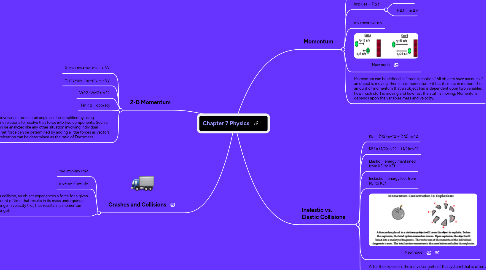Chapter 7 Physics
by Harley Borden

1. 2-D Momentum
1.1. X: mv+mv=mv+mv --> Vx
1.2. Y: mv+mv=mv+mv --> Vy
1.3. Vx^2+Vy^2= V^2
1.4. Tan-1α = opp/adj
1.5. A situation involving a force at an angle can be simplified by using trigonometric relations to resolve that force into two components. Such a situation can be analyzed like any other situation involving individual forces. The net force can be determined by adding all the forces as vectors and the acceleration can be determined as the ratio of Fnet/mass.
2. Crashes and Collisions
2.1. mv+mv=mv+mv
2.2. mv+mv=(m+m)v
2.3. In a collision, an object experiences a force for a given amount of time that results in its mass undergoing a change in velocity (i.e., that results in a momentum change).
3. Momentum
3.1. ∆p = m∆v
3.2. impluse = F∆t
3.2.1. F∆t = ∆p
3.2.2. F∆t = m∆v
3.3. mv+mv=mv+mv
3.4. New node
3.5. Momentum can be defined as "mass in motion." All objects have mass; so if an object is moving, then it has momentum - it has its mass in motion. The amount of momentum that an object has is dependent upon two variables: how much stuff is moving and how fast the stuff is moving. Momentum depends upon the variables mass and velocity.
4. Inelastic vs. Elastic Collisions
4.1. KEi = (1/2)mv^2 + (1/2)mv^2
4.2. KEf = (1/2)mv^2 + (1/2)mv^2
4.3. Elastic = energy mantained from KEi to KEf
4.4. Inelastic = energy lost from KEi to KEf
4.5. New node
4.6. After the explosion, the individual parts of the system (that is often a collection of fragments from the original object) have momentum. If the vector sum of all individual parts of the system could be added together to determine the total momentum after the explosion, then it should be the same as the total momentum before the explosion. Just like in collisions, total system momentum is conserved.


